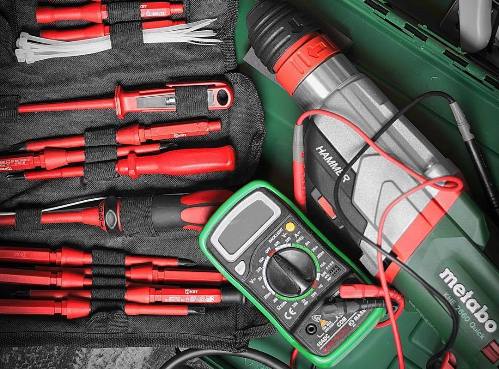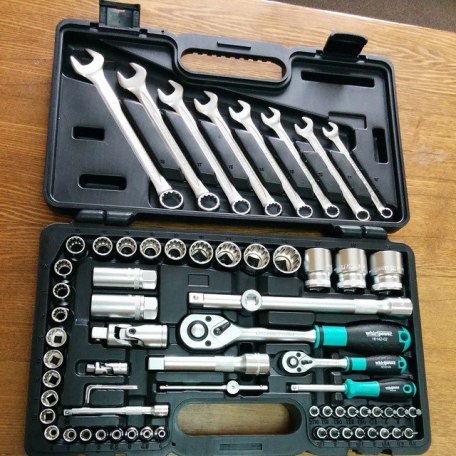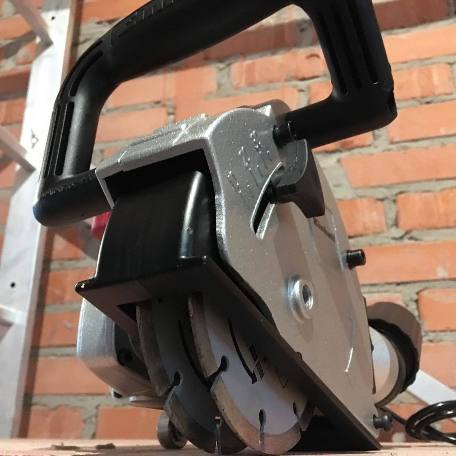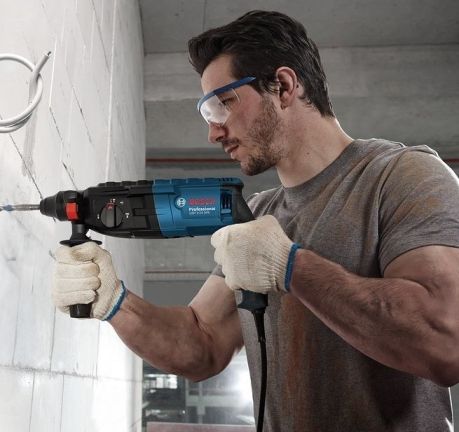Categories: Electric installation work
Number of views: 45483
Comments on the article: 0
What tools are needed to perform electrical work
To carry out electrical work: dismantling and installing electrical wiring, installing and connecting various equipment, repairing electrical wiring, preparing plugs, holes and recesses for laying electrical wiring, etc., you will need a wide variety of tools - from simple screwdrivers, measuring instruments, right up to the shtroborez or punch.
The choice of tools for electrical work is largely dependent on the place of use (for example, homework, field work, work at the enterprise), as well as on the professional skills of an electrician, electrician. It should be borne in mind that the speed and quality of the work performed will directly depend on the quality and functionality of the tool.
Consider the most common tools, fixtures and materials needed to perform electrical work.

Screwdrivers or screwdriver sets
This tool can not be dispensed with when installing sockets and switches, screw terminals and electrical devices in the distribution panel. For work, you will need screwdrivers of different sizes and types - Phillips, flat, hexagonal. For installation and maintenance of some equipment, screwdrivers with specialized tips are required.
When performing electrical work, such a tool as an impact screwdriver will not be out of place. This is a special screwdriver designed to loosen “stuck” screws, screws, screws, which cannot be unscrewed with a conventional screwdriver.

Indicators, voltage indicators, electrical protective equipment
When performing electrical work, the most important issue is electrical safety issue, therefore, in the tool list of each electrician should be indicator screwdriver and voltage indicator. An indicator screwdriver will help determine the presence or absence of a phase, but the absence of voltage in the wiring must be determined precisely by the voltage indicator.
There are universal voltage indicators indicating the magnitude of the measured voltage, which can be used as a tester to check the integrity of the circuits, as well as an indicator of the presence of phase. As an alternative to a voltage indicator in electrical wiring up to 1000 V, a multimeter can be used.

Also an indispensable assistant to an electrician is hidden wiring indicator, which greatly accelerates the process of repairing damage to electrical wiring.
Considering the issue of electrical safety, it should be mentioned that an electrician must have the necessary protective equipment, the list of which corresponds to the nature and conditions of the work performed. To protect against electric shock, a tool with insulating handles, insulating rods, insulating pincers, dielectric gloves, dielectric stands or rubber mat, and dielectric shoes are used.
Multimeter and other measuring instruments
Multimeter is a multifunctional device designed to measure basic electrical quantities. This is an indispensable device for an electrician, it allows you to measure voltage in a wide range of both direct and alternating current, resistance, current strength.
The presence of a dialing mode allows you to determine the integrity of fuses and electrical wiring, and also allows you to quickly understand the complex circuits of switchboards.
For ease of load measurement, special clamp meter, allowing to measure the load without the need to include the device in an open circuit.Combined measuring instruments combining the functions of current clamps and a multimeter are convenient for an electrician in operation.

To accurately determine the state of insulation, transient resistance measurements should be produced by megger - Another measuring device in the list of electrician. This measuring device is used in the installation and maintenance of power equipment, large switchboards, switchgears.
To accurately measure the cross-section of the cable conductors, to carry out accurate measurements during the installation of various elements, a measuring device such as a caliper is used.
Pliers, side cutters, specialized tools
Pliers are an indispensable tool when performing electrical work. They are used for cable termination, for twisting wires, bending wires, twisting bolted joints and other works. Side cutters (nippers) are designed for biting the cores of cables and wires in the process of laying electrical circuits.
There is a combined hand tool - pliers, replacing the two above tools.
When performing electrical work, pliers of a special shape can also be used - the so-called long-nose pliers, thin-nose pliers, platypuses, and round-nose pliers.

For frequent and regular work, for the convenience of stripping insulation, a special tool is used - a stripper. For one-time and irregular work, it is not advisable to purchase this tool: removal of insulation can be performed using side cutters or a knife.
If crimping is chosen as the method of connecting the conductors, then in this case it is necessary to have a tool such as crimping pliers (press tongs).
A set of wrenches will be needed when installing and connecting power electrical equipment, assembling and connecting large switchboards.

Power tool
For the preparation of a strob of a hidden electrical wiring, it is used chipper. This power tool is purchased for large volumes of work.
For infrequent work, you can use an angle grinder or an ordinary hammer with a pair of chisels. An angle grinder (grinder) is also often used during installation for cutting metal elements and grinding them.

An electric drill or screwdriver is used for mounting various fastening elements, drilling holes for fastening or for installing various elements of electrical wiring.
To perform installation on brick or concrete walls, it becomes necessary to drill holes - this requires hammer drill or hammer drill. A rotary hammer can also be used as an alternative to a chisel cutter when mounting a cable for concealed wiring.
If necessary, soldering joints is used soldering iron, and solder and soldering fluxes. As an alternative to an electric soldering iron, a gas torch or gas soldering iron can be used.
Another way to connect conductors is welding, which is carried out special twist welding machine. When performing electrical work, it may be necessary to weld metal elements of electrical equipment - for this, portable inverter-type welding machines are used.
If it is necessary to use a power tool, an electrician should always have personal protective equipment - a respirator, a protective helmet, goggles, masks, etc.

In addition to the above, in the bag of an electrician there should always be an insulating tape, tape measure, pencil (marker), heat shrink tubing, files, sandpaper, knife, a set of drills for working on different surfaces, dowels for quick installation, a hacksaw for metal, etc.
When performing electrical work, many other equipment, tools, materials can be used.In this case, it depends on the specific specialization of the electrician and the nature of the work performed.
See also at bgv.electricianexp.com
:
